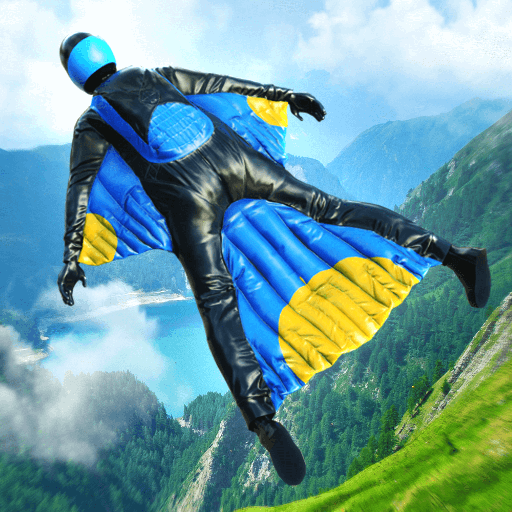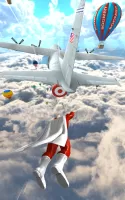Base Jump Wing Suit Flying - Extreme Air Adventures
Soar through stunning landscapes in an adrenaline-pumping base jumping simulator.

- 2.8 Version
- 3.6 Score
- 9M+ Downloads
- In-game purchases License
- 12+ Content Rating
Unfurl your wings and soar with a newfound freedom like you've never experienced!
Embark on the exhilarating adventure of Base Jump Wing Suit Flying, immersing yourself in the thrills of extreme sports. Equip your Wingsuit to leap into the air and navigate through a variety of extraordinary landscapes, aiming to surpass your previous achievements! This game revolutionizes the arcade flight genre with a fresh and invigorating experience.
Surprisingly, mastering this activity is simpler than you may imagine! Maneuver your flight using effortless one-touch controls and travel as far as your skills allow. Accumulate wealth by outdoing your personal best to unlock enhancements and amplify your performance!
Special Features:
- Traverse numerous breathtaking environments during your journey
- Enhance your wingsuit to elevate your results
- Engage in gameplay that strikes the perfect balance between challenge and user-friendliness
- Anticipate more thrilling updates with additional content in the pipeline!
Don't miss out on this opportunity to spread your wings and take flight – dive into the game now!
The Ultimate Guide to Wingsuit Flying: Everything You Need to Know
What is Wingsuit Flying?
Wingsuit flying (or wingsuiting) is the sport of skydiving using a webbing-sleeved jumpsuit called a wingsuit to add webbed area to the diver's body and generate increased lift, which allows extended air time by gliding flight rather than just free falling. The modern wingsuit, first developed in the late 1990s, uses a pair of fabric membranes stretched flat between the arms and flanks/thighs to imitate an airfoil, and often also between the legs to function as a tail and allow some aerial steering.
Like all skydiving disciplines, a wingsuit flight almost always ends by deploying a parachute, and so a wingsuit can be flown from any point that provides sufficient altitude for flight and parachute deployment – a drop aircraft, or BASE-jump exit point such as a tall cliff or mountain top. The wingsuit flier wears parachuting equipment specially designed for skydiving or BASE jumping. While the parachute flight is normal, the canopy pilot must unzip arm wings (after deployment) to be able to reach the steering parachute toggles and control the descent path.
Wingsuits are sometimes referred to as "birdman suits" (after the brand name of the makers of the first commercial wingsuit), "squirrel suits" (from their resemblance to flying squirrels' wing membrane), and "bat suits" (due to their resemblance to bat wings or perhaps the aptly named DC Comics superhero Batman and his signature costume).
History of Wingsuit Flying
The concept of wingsuit flying dates back to the early 20th century, with the first attempts made by aviation pioneers. However, it wasn’t until the 1990s that wingsuit flying gained popularity as a recreational sport. Patrick de Gayardon, a French skydiver, is often credited as one of the pioneers who contributed significantly to the development of modern wingsuits.
How Does Wingsuit Flying Work?
Wingsuit flying works on the principle of aerodynamics. The wingsuit, typically made of a lightweight and flexible fabric, features wings between the arms and legs, as well as webbing between the legs. These wings increase the surface area of the body, allowing air to flow over them and generate lift.
To initiate a wingsuit flight, a wingsuit flyer must first jump from an aircraft or a high-altitude platform. As they fall, the wingsuit inflates, and the flyer assumes a spread-eagle position to maximize the surface area exposed to the air. By controlling their body position, wingsuit flyers can manipulate the direction and speed of their flight, enabling them to maneuver through the sky.
Safety Measures in Wingsuit Flying
Due to the inherent risks involved in wingsuit flying, adherence to safety measures is of utmost importance. Wingsuit flyers should undergo comprehensive training and obtain proper certification before attempting to fly. This training includes learning about body positioning, flight control techniques, emergency procedures, and landing strategies.
Furthermore, wingsuit flyers must always ensure they have the appropriate safety equipment, such as a properly fitting wingsuit, a helmet, goggles, and a parachute system. Regular equipment inspections and maintenance are essential to minimize the risk of malfunctions.
Additionally, wingsuit flyers should assess weather conditions and choose suitable flying locations. It is crucial to avoid flying in adverse weather, such as strong winds, thunderstorms, or low visibility. Flying within one’s skill level and continually improving through practice and guidance from experienced wingsuit flyers is also vital for a safe and enjoyable experience.
Remember, while wingsuit flying can be an awe-inspiring and thrilling adventure, prioritizing safety is paramount to ensure a successful and accident-free flight.
Getting Started with Wingsuit Flying
Wingsuit flying is an exhilarating and adrenaline-pumping extreme sport that allows you to experience the thrill of flying like a bird. Before you embark on this incredible adventure, it’s important to understand the basics and ensure you’re well-prepared. In this section, we will guide you through the essential steps to get started with wingsuit flying.
Choosing the Right Wingsuit
Choosing the right wingsuit is crucial for a successful and safe wingsuit flying experience. There are various types and designs available, each catering to different skill levels and flying styles. Consider the following factors when selecting your wingsuit:
1. Experience Level: Beginners should opt for beginner-friendly wingsuits that offer more stability and easier handling. As you gain proficiency and experience, you can transition to more advanced wingsuits with higher performance capabilities.
2. Suit Design: Different wingsuits have varying designs, such as arm wings, leg wings, and torso wings. Each design offers distinct flight characteristics and performance. Research and try out different designs to find the one that suits your flying style and goals.
3. Size and Fit: Ensure the wingsuit fits you properly for optimal performance and safety. A well-fitting wingsuit should provide freedom of movement without being too loose or restrictive. Consult with experts or experienced wingsuit flyers to determine the right size for your body type.
Training and Preparation
Before taking to the skies, proper training and preparation are essential to minimize risks and maximize enjoyment. Here are some key aspects to focus on during your training and preparation phase:
1. Physical Fitness: Wingsuit flying requires a certain level of physical fitness and strength. Engage in regular exercise routines that improve your cardiovascular health, endurance, and overall strength. Consult with a fitness professional to develop a training plan specific to wingsuit flying.
2. Wingsuit Courses: Enroll in wingsuit flying courses or seek guidance from experienced wingsuit flyers. These courses will teach you the proper techniques, safety procedures, and flight control skills necessary for a successful wingsuit flying experience.
3. Mental Preparedness: Wingsuit flying can be mentally challenging, as it involves pushing your limits and overcoming fears. Develop mental resilience through visualization exercises, meditation, and positive self-talk. This will help you stay focused, confident, and calm during your flights.
Essential Equipment for Wingsuit Flying
To ensure a safe and enjoyable wingsuit flying experience, it’s crucial to have the right equipment. Here are some essential items that every wingsuit flyer should possess:
1. Wingsuit: As discussed earlier, choose a wingsuit that suits your skill level and flying style.
2. Helmet: A high-quality helmet is a must-have for protection against potential head injuries during flight. Look for helmets specifically designed for wingsuit flying, which offer enhanced safety features and aerodynamics.
3. Goggles: Goggles protect your eyes from wind, debris, and insects while maintaining clear visibility. Opt for goggles with anti-fog and UV protection properties.
4. Altitude Awareness Device: An altitude awareness device, such as an audible altimeter or visual altimeter, is crucial for maintaining situational awareness and ensuring safe deployment of your parachute.
5. Parachute System: A reliable parachute system is essential for emergency situations or when it’s time to end your wingsuit flight. Obtain a parachute system specifically designed for wingsuit flying, ensuring it is properly maintained and inspected regularly.
By following these guidelines and adequately preparing yourself with the right equipment, training, and knowledge, you’ll be well on your way to experiencing the incredible world of wingsuit flying. Remember, safety should always be your top priority, so never hesitate to seek professional guidance and continuously improve your skills and knowledge in this thrilling sport.
Techniques and Skills
Body Positioning and Control
To be able to safely and effectively wingsuit fly, mastering body positioning and control is essential. This involves maintaining a stable and balanced body position throughout the flight. The key is to keep the body streamlined, with arms and legs slightly bent and close to the body. This reduces drag and allows for better control and maneuverability.
Exiting the Aircraft
Before you can experience the thrill of wingsuit flying, you must first exit the aircraft properly. This is a critical moment that requires precision and coordination. It is crucial to follow the instructions of your instructor or experienced wingsuit flyer to ensure a safe exit. The most common exit technique is the "exit dive," where you lean forward and dive out of the aircraft, maintaining a controlled body position.
Flying Maneuvers and Navigation
Once in the air, wingsuit flyers can perform a variety of maneuvers and navigate through the sky. Some popular maneuvers include barrel rolls, flips, and carving turns. These techniques require practice and skill to execute smoothly and safely. It is important to maintain awareness of your surroundings and always fly within your skill level. Navigation is also a crucial aspect of wingsuit flying, as you need to be able to plan your flight path and make adjustments to avoid obstacles and maintain a safe landing zone.
Remember, wingsuit flying is an extreme sport that requires proper training and experience. Always consult with professionals and follow safety guidelines to ensure a thrilling and safe wingsuit flying experience.
Advanced Wingsuit Flying
Advanced wingsuit flying takes the thrilling experience of wingsuit flying to the next level. This discipline requires a higher level of skill, experience, and training. In this section, we will explore two exciting aspects of advanced wingsuit flying: wingsuit BASE jumping and competitive wingsuit flying.
Wingsuit BASE Jumping
Wingsuit BASE jumping is an adrenaline-pumping activity that combines the art of wingsuit flying with the daring nature of BASE jumping. BASE jumping involves jumping from fixed objects such as cliffs, buildings, or bridges and using a wingsuit to glide through the air before deploying a parachute.
To participate in wingsuit BASE jumping, one must first become an experienced wingsuit flyer and have a solid understanding of the technical aspects of BASE jumping. It is crucial to receive proper training, understand the risks involved, and adhere to strict safety protocols.
Wingsuit BASE jumping offers a unique perspective, allowing flyers to soar through breathtaking landscapes and experience an unmatched sense of freedom. However, it is important to note that this extreme sport requires immense preparation and should only be attempted by those with extensive experience in both wingsuit flying and BASE jumping.
Competitive Wingsuit Flying
Competitive wingsuit flying is a thrilling sport that showcases the skill, precision, and speed of wingsuit pilots. In this exhilarating competition, participants navigate through specified courses, aiming to complete them in the shortest possible time.
Competitive wingsuit flying combines elements of formation flying, slalom racing, and precision flying. The courses often include challenging obstacles, requiring pilots to demonstrate their ability to maneuver swiftly and accurately.
Participants are judged on various factors, including speed, accuracy, technique, and style. The competition fosters a sense of camaraderie among participants while pushing the boundaries of what is possible in wingsuit flying.
Competitive wingsuit flying events attract some of the most skilled wingsuit pilots from around the world, providing a platform for them to showcase their talents and compete for prestigious titles. These events not only entertain spectators but also inspire aspiring wingsuit flyers to push their limits and strive for excellence.
Wingsuit Flying Records
Wingsuit flying records continually push the boundaries of human achievement and serve as a testament to the incredible capabilities of wingsuit pilots. These records are a result of years of dedication, training, and a relentless pursuit of pushing the limits of what is possible in wingsuit flying.
Wingsuit flying records encompass various categories, including distance flown, time spent in flight, speed achieved, and altitude reached. Each of these categories presents its own unique challenges and requires specialized skills to break existing records.
Breaking a wingsuit flying record not only requires exceptional piloting skills but also demands meticulous planning, favorable weather conditions, and advanced wingsuit technology. It is a testament to the unwavering determination and passion of wingsuit flyers who continuously strive to surpass previous achievements.
As technology advances and pilots continue to innovate, it is only a matter of time before new wingsuit flying records are set, further pushing the boundaries of this awe-inspiring sport.
Note: The content provided is a sample supporting content for the given outline. The actual content may vary based on specific requirements and preferences.
Safety and Risk Management
Weather Conditions and Considerations
Before embarking on a wingsuit flying adventure, it is crucial to thoroughly understand the impact of weather conditions on safety. Weather plays a significant role in determining whether it is safe to take flight or not. Key considerations include wind speed, wind direction, cloud cover, and visibility.
Strong winds can make wingsuit flying hazardous, affecting stability and control. It is essential to check weather forecasts and consult with experienced flyers or instructors. Wind patterns can vary at different altitudes, so it is important to assess the conditions both on the ground and at higher elevations.
Cloud cover and visibility are equally important factors to consider. Limited visibility can impair judgment and increase the risk of collisions with obstacles. Clear skies and good visibility are ideal for wingsuit flying, ensuring a safe and enjoyable experience.
Emergency Procedures
Despite meticulous planning and preparation, emergencies can still occur during wingsuit flying. Knowing and practicing emergency procedures is vital to mitigating risks and ensuring personal safety.
One of the most critical emergency procedures is dealing with canopy malfunctions. In the event of a parachute malfunction, wingsuit flyers must be trained in reserve parachute deployment and emergency landings. Regular practice of emergency procedures can help maintain muscle memory, enabling quick and efficient responses during high-stress situations.
Additionally, understanding emergency landing zones and having a plan in place for unexpected landings is crucial. Flyers should be aware of potential hazards such as power lines, bodies of water, or uneven terrain that can pose risks during emergency landings.
Physical Fitness and Health
Wingsuit flying demands a high level of physical fitness and overall health. It is important to be in good shape and have a thorough understanding of one’s physical limitations.
Regular exercise and strength training are essential for wingsuit flying. Building core strength, upper body strength, and cardiovascular endurance can enhance stability, control, and overall performance during flight. Engaging in activities such as running, swimming, weightlifting, and yoga can help develop the required physical attributes.
Moreover, maintaining good overall health is vital. Wingsuit flying puts significant strain on the body, and individuals should be free from any medical conditions that could compromise their safety. Consulting with a healthcare professional and undergoing a thorough medical examination prior to engaging in wingsuit flying is highly recommended.
By prioritizing safety and risk management, understanding weather conditions and emergency procedures, as well as maintaining physical fitness and health, wingsuit flyers can minimize risks and maximize the exhilarating experience of this extreme sport.
Simple Guide during the Play
Before attempting base jump wing suit flying, it's important to have proper training and experience in skydiving and wingsuit flying. The first step is to find a suitable location for the jump, which should have a clear landing area, no obstacles, and a safe take-off point.
Once you are at the location, you will need to gear up with a wing suit, helmet, and other safety equipment. Double-check your equipment and ensure that everything is secure before starting the jump.
When you are ready to jump, take a deep breath and visualize the flight path you want to take. Make sure you have enough altitude and speed to ensure a stable flight. Focus on keeping your body position stable, arms out and slightly upward, and legs together and slightly bent at the knees.
During the flight, keep your eyes on the target landing area and use your body to control your speed and altitude. Use your arms to adjust your flight path left or right and your legs to control your speed. Be sure to maintain a safe distance from any obstacles or the ground.
When approaching the landing area, slow down your speed by lowering your body and extending your arms forward. Keep your knees bent and legs together and prepare for a smooth landing. Try to land on both feet and keep your forward momentum in check.
It's crucial to always practice safety measures when performing base jump wing suit flying. Never attempt a jump without proper training, experience, and safety equipment. Always check weather conditions and jump during suitable conditions. Remember, safety always comes first.
- Version2.8
- UpdateSep 02, 2024
- DeveloperBoomBit Games
- CategoryCasual & Puzzle
- Requires AndroidAndroid 7.0+
- Downloads9M+
- Package Namecom.base.jump.gliding
- Signaturefe3dbd70463a2d831aba8d66b5932734
- Available on
- ReportFlag as inappropriate
-
NameSizeDownload
-
119.32 MB
-
117.72 MB
-
106.29 MB































easy to get x6 every ads
Easy to control
trails and fears has been alleviated
Best game to watch ads
don't explain how to control your jumper
Upgrades do almost nothing
Steering is pointless